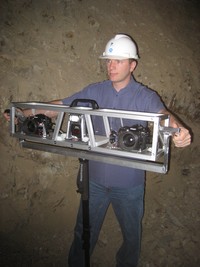Nickel Rim South is one of the first underground mines in the world to fully deploy Sirovision 3-D photomapping technology.
The imaging system, developed by the exploration and mining division of Australia’s Commonwealth Scientific and Industrial Research Organization (CSIRO), does away with the traditional practice of sending geologists underground to map the face. Instead, miners will take stereo images of the face and back immediately after the face has been washed down with a high-pressure water scaler. The images will be transmitted wirelessly to surface via the mine-wide fibre network. Software will then stitch the images together and the geologists will map from the images.
The quality of the information is a lot better using Sirovision photomapping, said Greg Snyder, Nickel Rim South geology lead.
“A lot of times, the geologist goes down on a set schedule and the round may not be fully prepped or washed down, so he’s not getting as clear a picture. With the computer system, you can go in, take a look, flip it over and see things that you wouldn’t be able to see if you’re standing five metres away to stay clear of the unsupported ground.”
The technology also provides a permanent archive of images, allowing geologists to go back and review the mapping at their leisure. This is especially advantageous, given Nickel Rim South’s use of shotcrete for primary support.
Sirovision was developed originally for mapping in open pits and is only now being introduced into underground operations. “We’re one of the pioneers of this technology,” said Snyder.
Nickel Rim South will also be making use of nickel probing to test blastholes for mineralization. Probing the blastholes within the production rings – especially around the edges of the panels – is an effective method of controlling grade and reducing waste.
“Probing on the production rings will tell you if there’s conductivity,” said Snyder. “That allows us to reduce blasting material. This technology has been in place now for a while and we have used it quite a bit at Raglan and other operations. It saves us time and money.”



